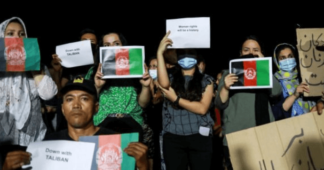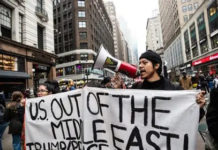Afghan women never asked for US air strikes.
By Rafia Zakaria
August 17, 2021
On a March evening in 1999, a wealthy Hollywood socialite named Mavis Leno, the wife of late-night superstar Jay Leno, held a fundraiser to which she invited her rich and/or famous friends. The event was to benefit the Feminist Majority Foundation’s campaign to “End Gender Apartheid in Afghanistan,” which highlighted the barbaric conditions of women living under Taliban rule. (Nowhere, of course, did anyone point out that the Taliban owed its strength at least in part to US foreign policy.) Before long, actresses like Susan Sarandon and Meryl Streep signed on and made the issue a cause célèbre.
Then came September 11, 2001, and the revelation that the organization behind the attack, Al Qaeda, was holed up in Afghanistan. The George W. Bush administration, always looking for justifications for war, found just the thing in the Feminist Majority’s campaign. By November, first lady Laura Bush was arguing that the reason for the war was to “liberate Afghan women.” By November 20, the leaders of the Feminist Majority—including Ellie Smeal, the former head of the National Organization for Women—were attending events at the State Department and meeting with administration officials. The spring 2002 issue of Ms. magazine called the invasion a “coalition of hope,” adding bombs to the feminist toolkit.
The brand of feminism those women collectively championed is what I call “white feminism,” meaning that it refuses to consider the role that whiteness and racial privilege play in universalizing white feminist concerns, agendas, and beliefs as those of all feminism and all feminists. Of course, not all feminists who are white are white feminists. No matter the person’s skin color and gender, advocating for an anti-racist, anti-capitalist feminism is a threat to white feminism
Yet both within and outside the US government, the white feminists decided that war and occupation were essential to freeing Afghan women. Notable examples include then-Senator Hillary Clinton, who enthusiastically voted for the war, calling it a “restoration of hope,” and New York Representative Carolyn Maloney, who wore a blue burka to the House floor and made impassioned declarations about how claustrophobic the garment was. The enduring logic was that if they thought military intervention was a good thing, then Afghan women would too.
But groups like the Revolutionary Association of the Women of Afghanistan, a political organization that has denounced religious fundamentalism since its founding in 1977, opposed the US attacks and the US-backed government. Afghan feminists never asked for Meryl Streep’s help—let alone US air strikes.
The belief that white women knew what’s best for Afghan women goes deeper than Hollywood and political posturing. The hundreds of millions in development aid that the United States poured into its savior-industrial complex relied on second-wave feminists’ assumption that women’s liberation was the automatic consequence of women’s participation in a capitalist economy. One of the most expensive development programs that Americans brought to Afghanistan was PROMOTE, which cost $418 million and was intended to provide 75,000 Afghan women with training, internships, and jobs. When the program was audited in 2016, it was almost impossible to trace where all the money had gone. The influx of cash wasn’t just wasted; it helped kill Indigenous feminisms that might have worked to achieve more culturally relevant goals. The aid economy meant that Afghan women activists abandoned their own programs and rushed to American ones.
White feminism’s refusal to disaggregate whiteness—and its colonialist and oppressive associations—from feminism meant that the blueprint for empowerment was acting, by and large, like white women. The result was that those opposing the US presence saw authenticity in rejecting all that came via white feminism, which helped discredit all feminist ideas.
White feminism is a trickle-down feminism, and Afghan women are not the only ones it condescends to; Black women, Latina women, Asian women, and other women of color have trouble gaining entry into policy-making circles because their experiences of being a feminist, surviving as a single mother, working on a factory floor, or enduring years of racial discrimination are considered irrelevant. Those roles go to elite white women who have climbed the ladder, nudging out the very women they allegedly wish to help.
Many of the would-be white saviors of Afghan women are now insisting, with the same dogged and willful blindness that led them to support US imperialism in the first place, that the United States should have kept its military in the country to protect Afghan women. But an ill-conceived project cannot be fixed by continuing to make disastrous decisions. The best outcome would be for the white feminists who aided in the destruction of a country to forever forswear such lethal meddling
Published at www.thenation.com











